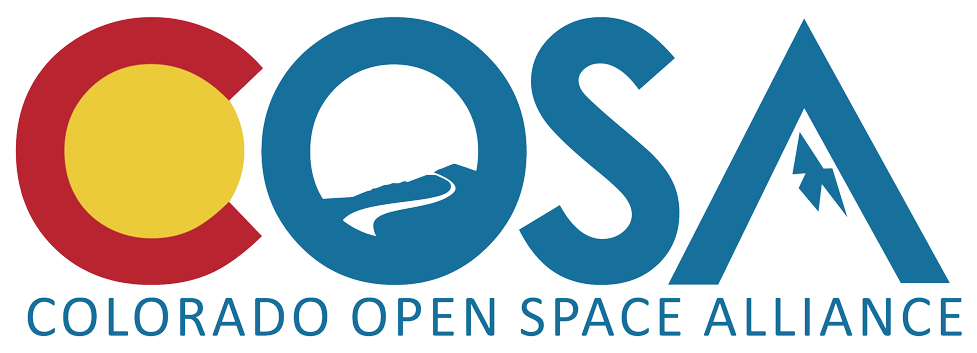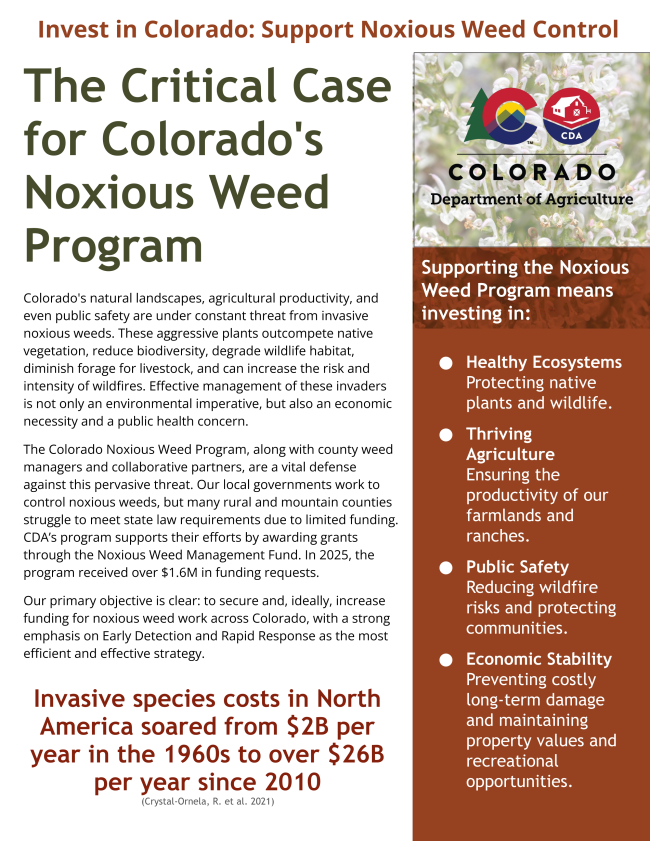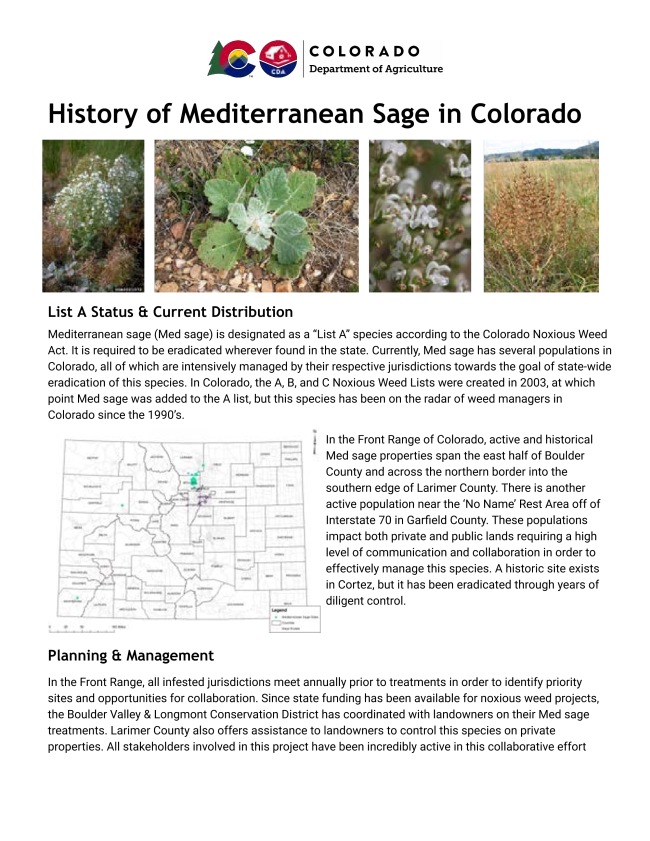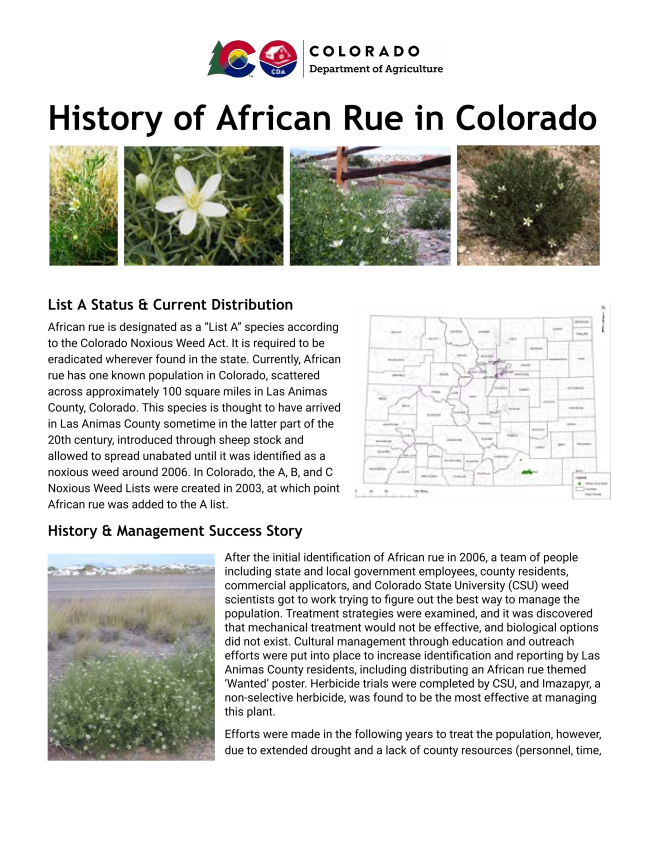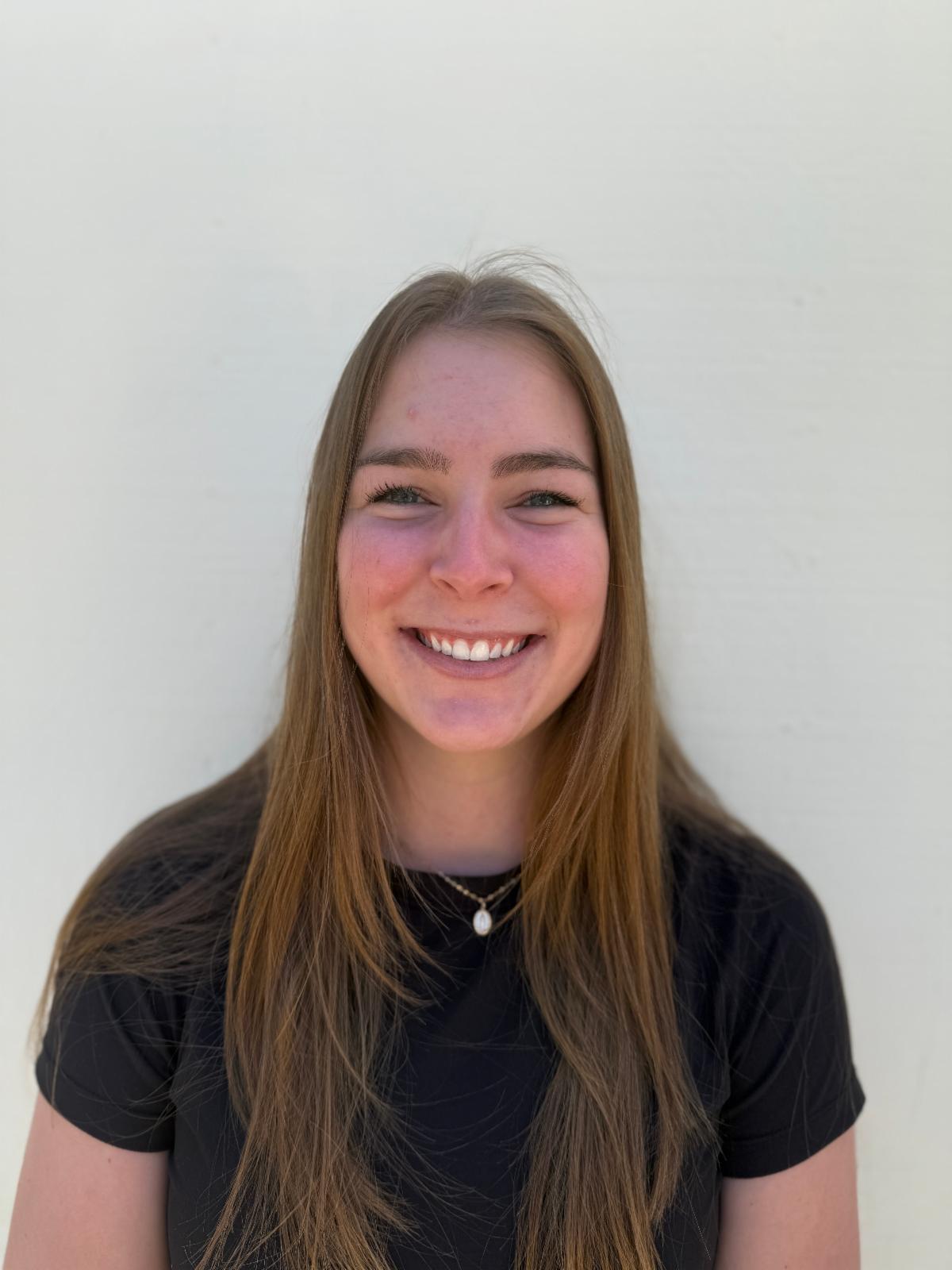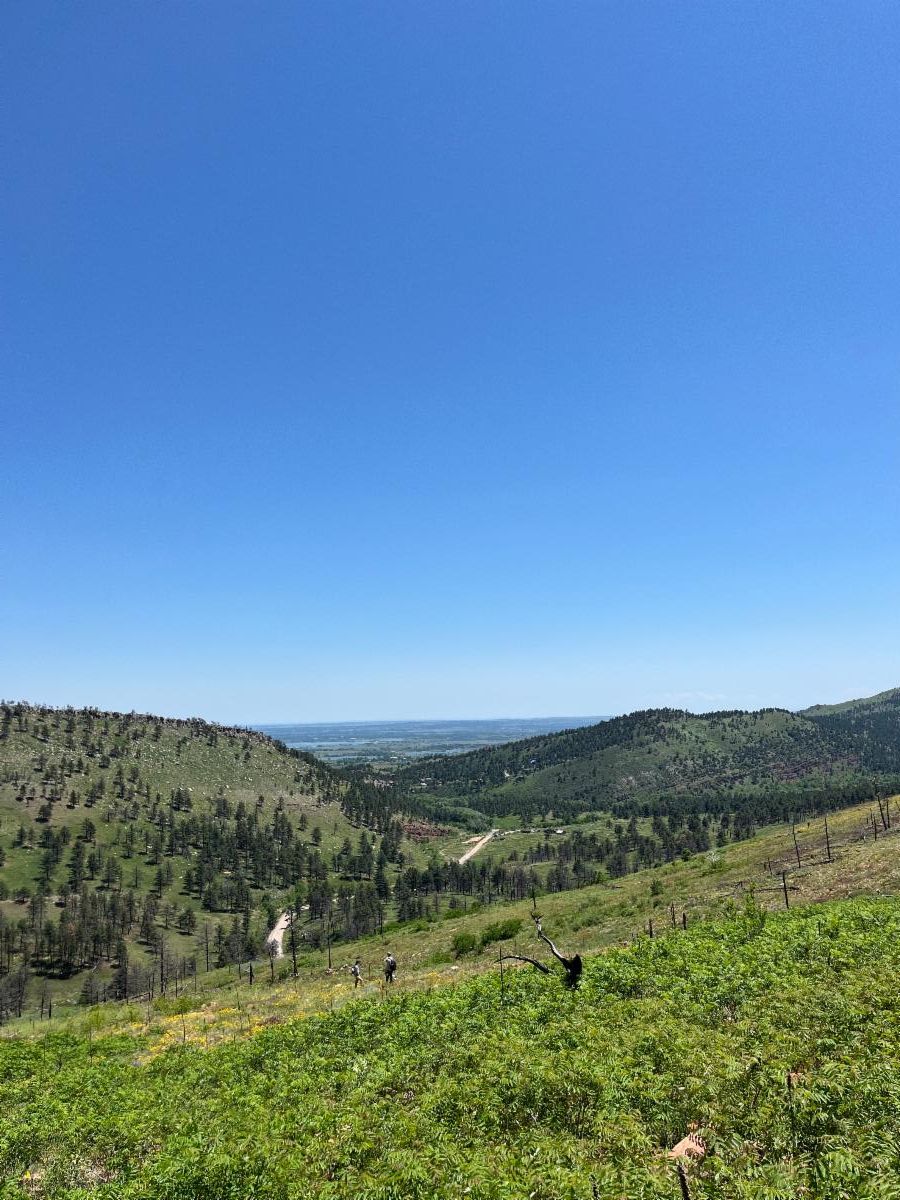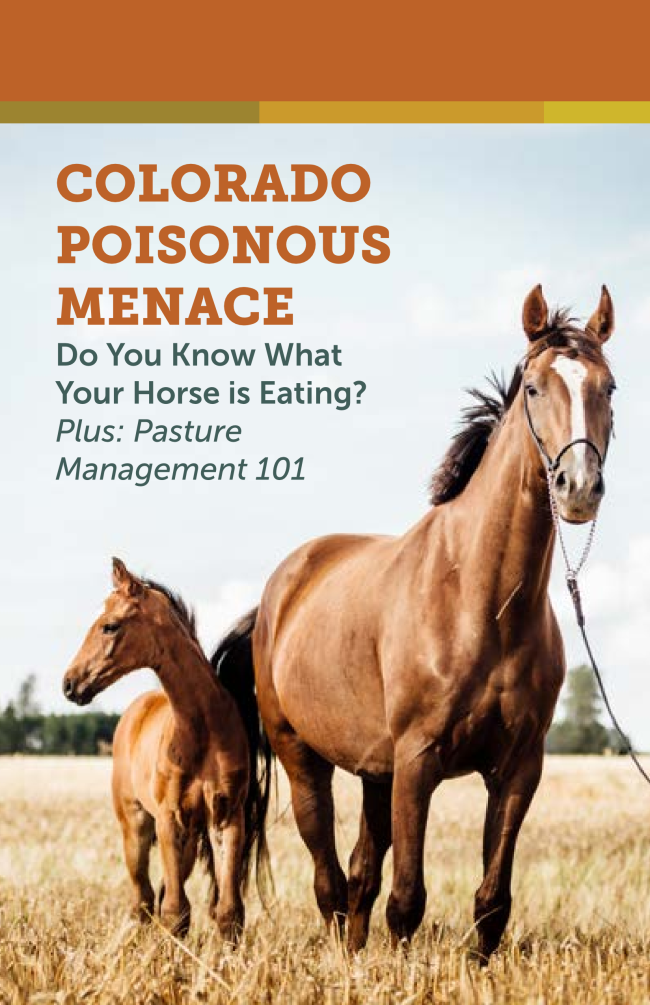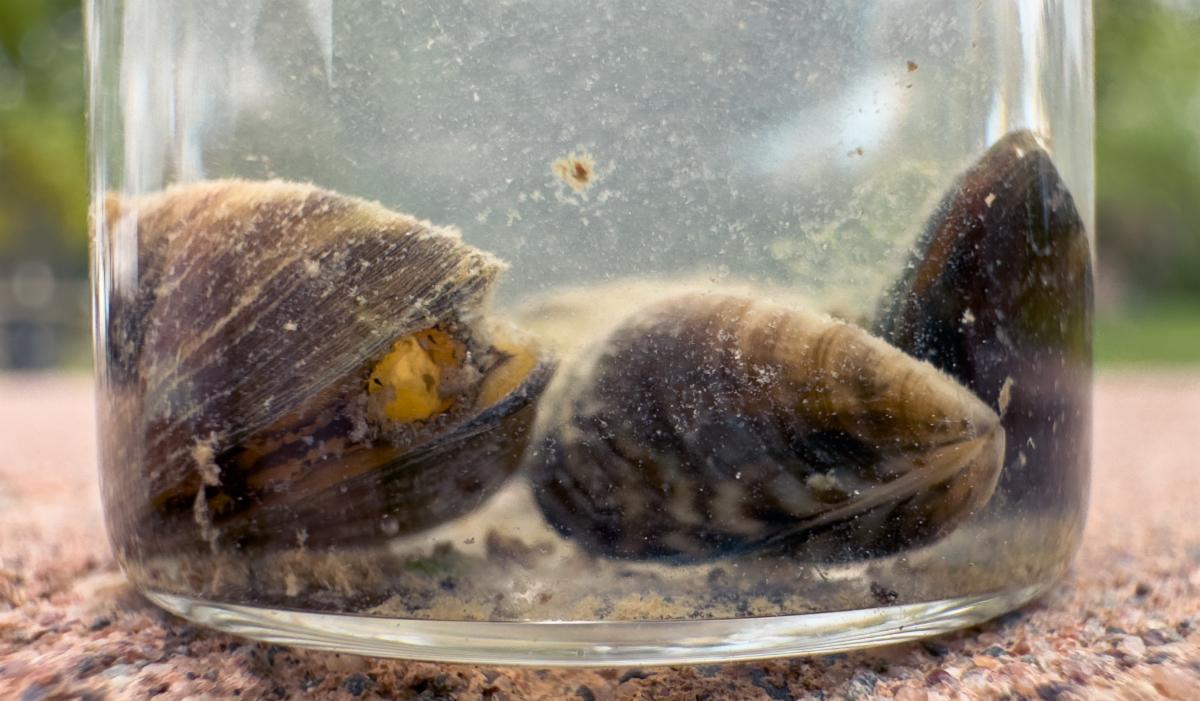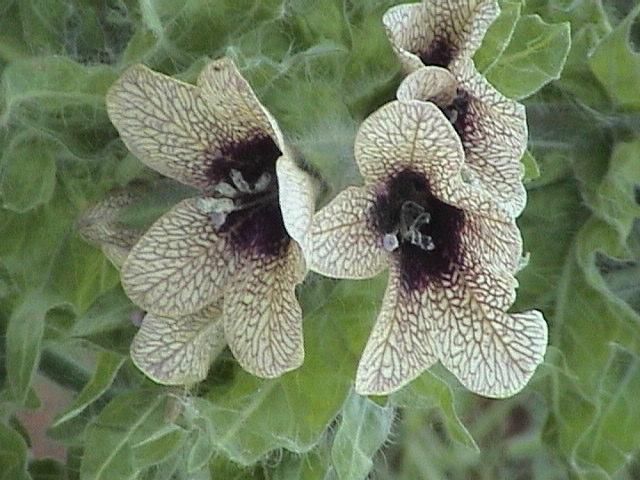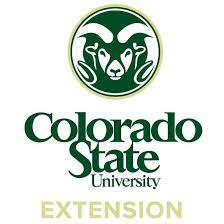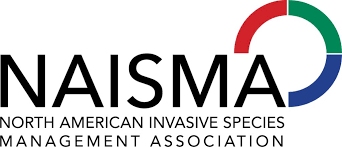Noxious Weed Program Newsletter
|
|
Updates for August 1st, 2025
|
|
Hello Colorado Landowners and Noxious Weed Managers!
It’s hard to believe August is already here – summer seems to be flying by! We truly appreciate all your ongoing efforts in managing Colorado’s noxious weeds. This newsletter has (lots of) program updates, so keep reading! |
|
| In this edition of our newsletter you will find:
- (Lots of) Program updates
- Other state agency updates
- Species to look out for
- Federal updates
- Upcoming conferences & events
- Job announcements
*Important: If you’re unable to see the complete newsletter, please click "view entire message" found at the bottom of this email. |
|
Join Our Team!
The Noxious Weed Program is hiring a 2-year, grant-funded Mapping & Data Specialist
The Mapping and Data Specialist position will use known noxious weed location data to produce spatial models through Geographic Information Systems (GIS) technology. These models will help predict where else the species may exist throughout the state of Colorado. Once models are run, and locations are predicted, this position will coordinate field visits to verify those predictions.
The position will work closely with county and municipal noxious weed managers to understand where else populations of prevalent but under-documented noxious weeds exist. They will work to fill in these data gaps, possibly coordinating volunteer mapping efforts and teaching volunteers how to use the EDDMapS mobile application to record locations of the noxious weeds.
Another large part of this position’s duties will be to help verify that grantees under the America the Beautiful grant are meeting metrics, working within a reasonable timeline, and completing their success stories. They will make field visits to project sites around the state.
Applications are due August 14th at 4:59 pm.
Please forward this this announcement to potential applicants.
Find the full job description and apply below: |
|
The Critical Case for Colorado’s Noxious Weed Program Advocacy Document
|
|
| Our Communications team at the Colorado Department of Agriculture recently developed a compelling advocacy document designed for legislators. This document makes a strong case for the vital importance of the Noxious Weed Program and the critical need for continued, and ideally increased, funding.
It outlines how unchecked invasive noxious weeds pose a significant and escalating threat to Colorado’s natural landscapes, agricultural productivity, and even public safety, emphasizing that effective management isn’t just an environmental concern but an economic and public health imperative.
The document highlights the program’s successes, particularly through Early Detection and Rapid Response (EDRR) efforts, and underscores that investing in weed control is an investment in healthy ecosystems, thriving agriculture, enhanced public safety, and long-term economic stability for the entire state.
Please feel free to share this document with Colorado legislators and other interested parties, to help us advocate for noxious weed management (and funding) around the state! |
|
|
Mediterranean Sage & African Rue Documents
|
|
Nicolette’s Internship Wrap-Up
|
|
| Here’s a note from our intern, Nicolette, about her time with us at the CDA, where she’s been helping out with two programs in the Conservation Services Division, including the Noxious Weed Program:
"During my internship, I had the opportunity to work with Emily Gilbert and Patty York on updating the noxious weed factsheets. My responsibilities included transferring information from the old sheets to the new, improved versions, as well as sourcing high-quality images to help the community better identify invasive weeds.
I joined Emily McGrath and her team for a field day pulling rush skeletonweed with Boulder County at Heil Valley Ranch. This hands-on experience was a great way to step out of the office and gain a deeper understanding of efforts to manage invasive plant populations.
I assisted Lora Richards by scanning seven years worth of Weed Free Forage documents, a project I completed halfway through my internship. I then went on to scan five years of Chemigation documents, finishing that project as well.
Patty also connected me with several outreach opportunities, including visits to Jack’s Agrivoltaic Farm and Sunflower Farms with Liza Nguyen (Soil Health Program). I really enjoyed learning about the different ways the Colorado Department of Agriculture supports agricultural operations through resources and assistance.
I’m grateful to everyone who helped me learn more about the work of the Colorado Department of Agriculture during my internship. Thank you for making it a meaningful and educational experience."
A huge thank you to Nicolette for all her hard work while she was interning here! |
|
| A group looks out while visiting the sunflower farm. |
| A group visit a site with the noxious weed rush skeletonweed. |
|
New "Poisonous Menace" Horse Brochures Available!
|
|
| We are excited to announce that the "Colorado Poisonous Menace" horse brochure has been updated!
This collaborative effort came about last year after we realized that all copies of the 2012 version had been depleted statewide. We are thrilled to release this newly updated version, a result of dedicated work from the CDA, Boulder County Horse Association, Natural Resources Conservation Service, Colorado State University Extension, local noxious weed managers, and other resource experts. A big thank you to everyone who contributed countless hours to this update.
The new versions include both a digital copy with live links, available on our website, and a printed version. To order copies of the printed brochure, please contact the CDA Noxious Weed Program at weeds. |
|
|
Other State Agency Updates
|
|
CPW’s Increased Sampling Efforts Result in Additional Zebra Mussel Detections in Western Colorado
Increased sampling efforts in Western Colorado have led to the discovery of adult zebra mussels in a private body of water in Eagle County and additional zebra mussel veligers in the Colorado River, Highline Lake, and Mack Mesa Lake.
These findings have prompted Colorado Parks and Wildlife to designate portions of the Colorado River and Mack Mesa Lake as "positive" for zebra mussels, leading to ongoing evaluation of eradication and management strategies. |
|
Black henbane
A single black henbane plant can produce an astounding 10,000 seeds that remain viable in the soil for many years.
Mature black henbane plants are poisonous to livestock and humans, potentially causing illness or even death if ingested.
This plant poses a significant threat, as it can rapidly infest rangelands, pastures, cultivated fields, roadsides, and disturbed areas. |
|
Dalmatian toadflax
A single Dalmatian toadflax plant can produce up to 500,000 seeds that remain viable in the soil for up to 10 years.
Mature Dalmatian toadflax plants contain glycosides that are toxic to livestock, potentially causing digestive issues if consumed in large quantities.
This plant poses a significant threat, as it can rapidly infest rangelands, pastures, cultivated fields, roadsides, and disturbed areas, outcompeting native vegetation and reducing forage quality. |
|
Reading the Tea Leaves: Targeted Grazing, Maybe Not What You Think
Targeted grazing offers a valuable approach for managing fuels in rangeland environments, but it requires careful planning.
This webcast with Research Ecologist Dr. Matt Reeves explores key considerations like poisonous plants, livestock acclimation, plant phenology, and nutritional concerns.
Dr. Reeves also introduces a decision support system designed to enhance strategic and prioritized targeted grazing across the U.S. West. |
|
Save the Date! Level 1 Noxious Weed Management Workshop with Montana State University
September 9th – 11th
The Level 1 Noxious Weed Management Workshop is a three-day intensive program on weed biology, ecology, and management, designed for both new and experienced professionals.
Held from September 9-11, 2025, at the C’mon Inn in Bozeman, this workshop is the first in a series offering advanced training for land managers and will provide pesticide applicator recertification credits.
Registration is $225, covering materials, supplies, and meals, and is limited to 30 participants on a first-come, first-served basis. Be sure to pre-register by August 22 and mention "MSU Weed Management" when booking a room at the C’mon Inn to receive the special rate. |
|
High Plains Journal Education Conference
August 6th – 8th
Wichita, Kansas
HPJ Live is an event created by and for the agricultural community, aiming to help farmers and ranchers maximize their time and increase profits.
It features 40 educational sessions on topics like cutting inputs, pest management, and exploring new markets, alongside keynote speakers discussing trade, regenerative agriculture, and drought resilience.
The goal is for attendees to gain actionable strategies and insights to advance their operations. |
|
Late Summer Wildflower Walk with Jefferson County
Wednesday, August 13th, 10:00 AM – 12:00 PM
Join a native plant expert for an easy two-hour walk at Pine Valley Ranch on Wednesday, August 13, 2025, from 10:00 a.m. to 12:00 p.m.
Along the North Fork of the South Platte River, you’ll discover colorful late-summer wildflowers and learn about plant defenses and historical human uses.
This walk is suitable for ages 10 and up with an adult. Remember to wear sturdy shoes, bring water, and dress for the weather. |
|
Best Garden Plants for the Western Slope
Wednesday August 13nd, 12:00 PM
Online Only
Join Mollie Freilicher from the CSU Extension Office in Grand Junction for a webinar discussing the challenges faced by gardeners in Western Colorado and highlighting top-performing plants from their demonstration garden.
This recorded webinar will be available on planttalk.org/webinars shortly after the live presentation. |
|
Restoring the Prairie: Conservation and Habitat Part 2
Tuesday, August 12th, 9:00 AM – 12:00 PM
Join Boulder County for the second part of their "Restoring the Prairie" series on August 15, 2025, from 9:00 AM to 10:30 AM, at the Agricultural Heritage Center.
This program will focus on practical ways to restore grassland prairie habitat for beneficial insects and birds, covering effective methods for selecting, planting, and maintaining native plants.
Registration is required, and attendance at Part 1 is not a prerequisite. |
|
NAISMA: Invasive Upcycling Summit
Wednesday, August 27th, 11:00 AM – 3:00 PM
Online Only
Join Invasive Impact Initiatives and North American Invasive Species Management Association (NAISMA) for the Invasive Upcycling Summit, a free virtual event on August 27, 2025, from 11:00 AM to 3:00 PM CDT.
This summit will showcase how individuals are transforming invasive species into useful, sustainable products through collaboration with local experts. It aims to educate communities on the ecological impact of invasive species and inspire new approaches to environmental care and circular design.
This event is open to everyone interested in creative solutions for ecological challenges. |
|
| Click on the button below to see conservation related job postings. |
|
| Know someone who might benefit from the Noxious Weed Newsletters?
Here is a direct link to sign up or you can contact Emily Gilbert. |
|
|
|
|
